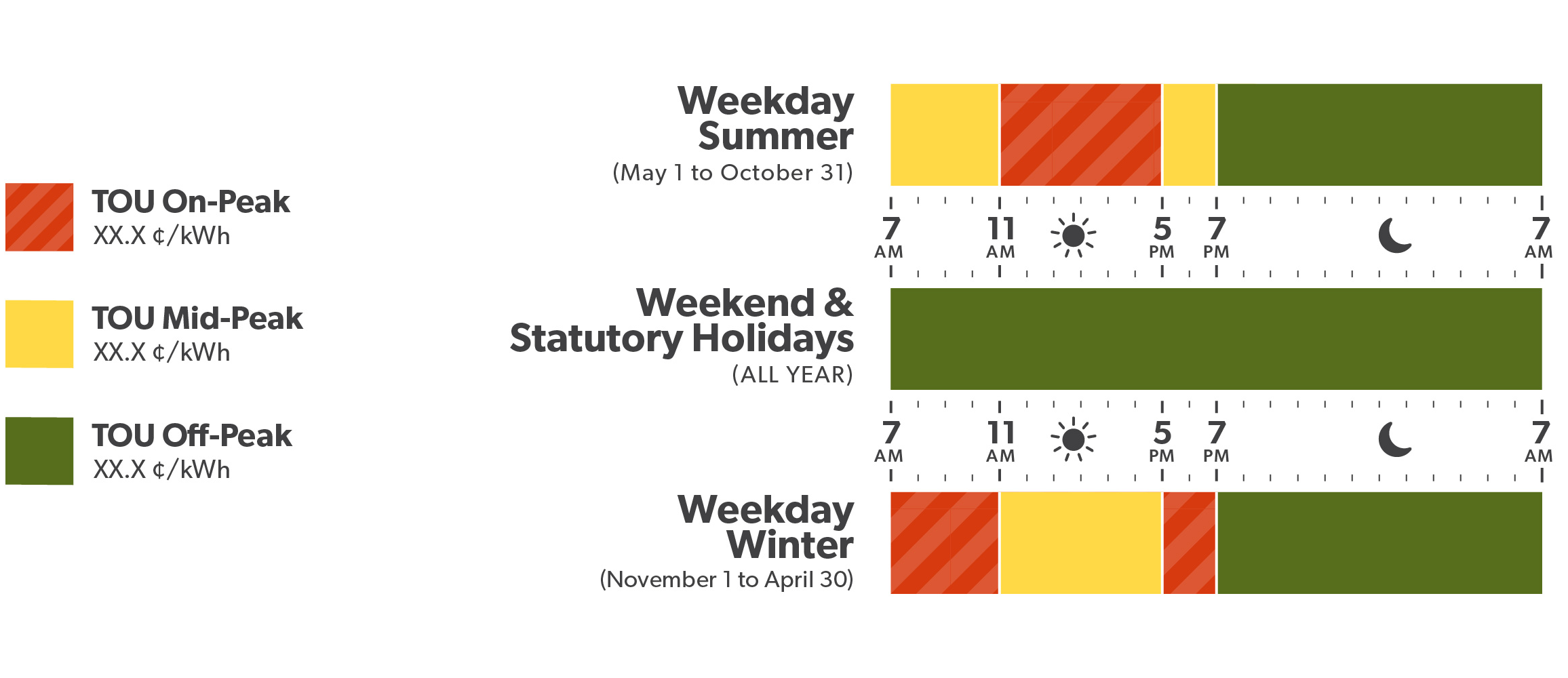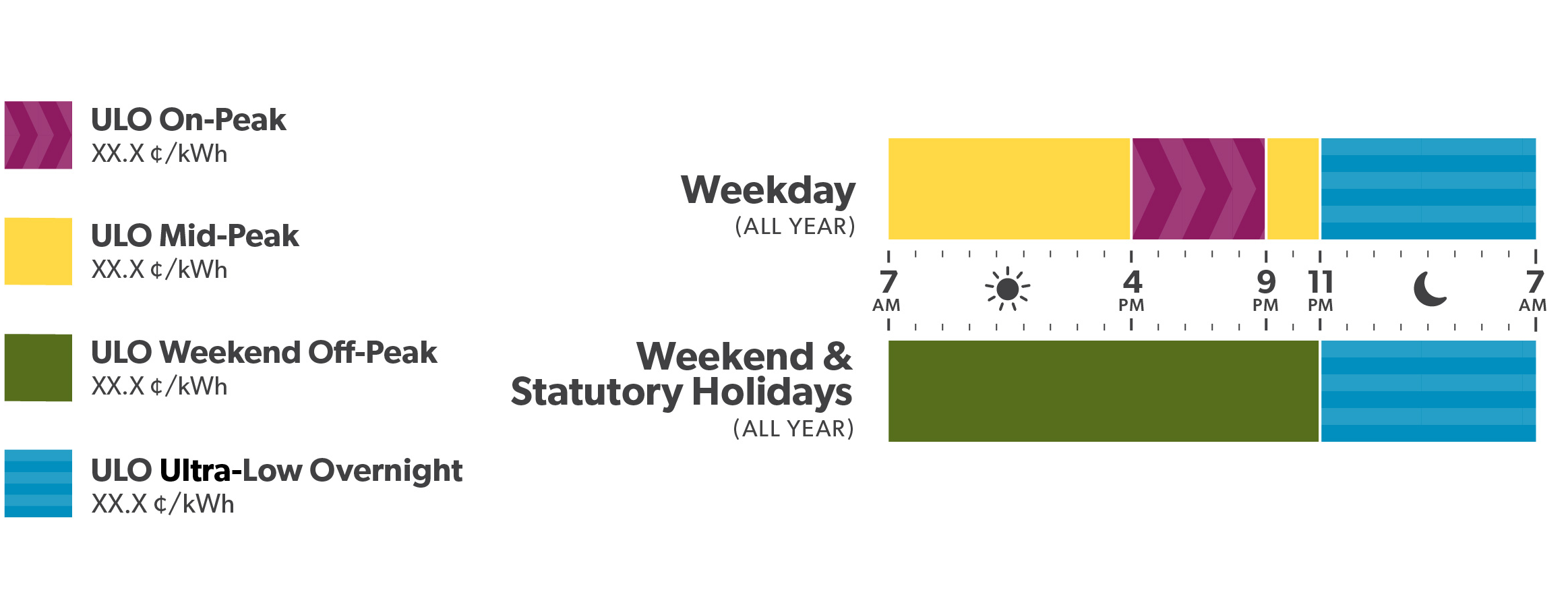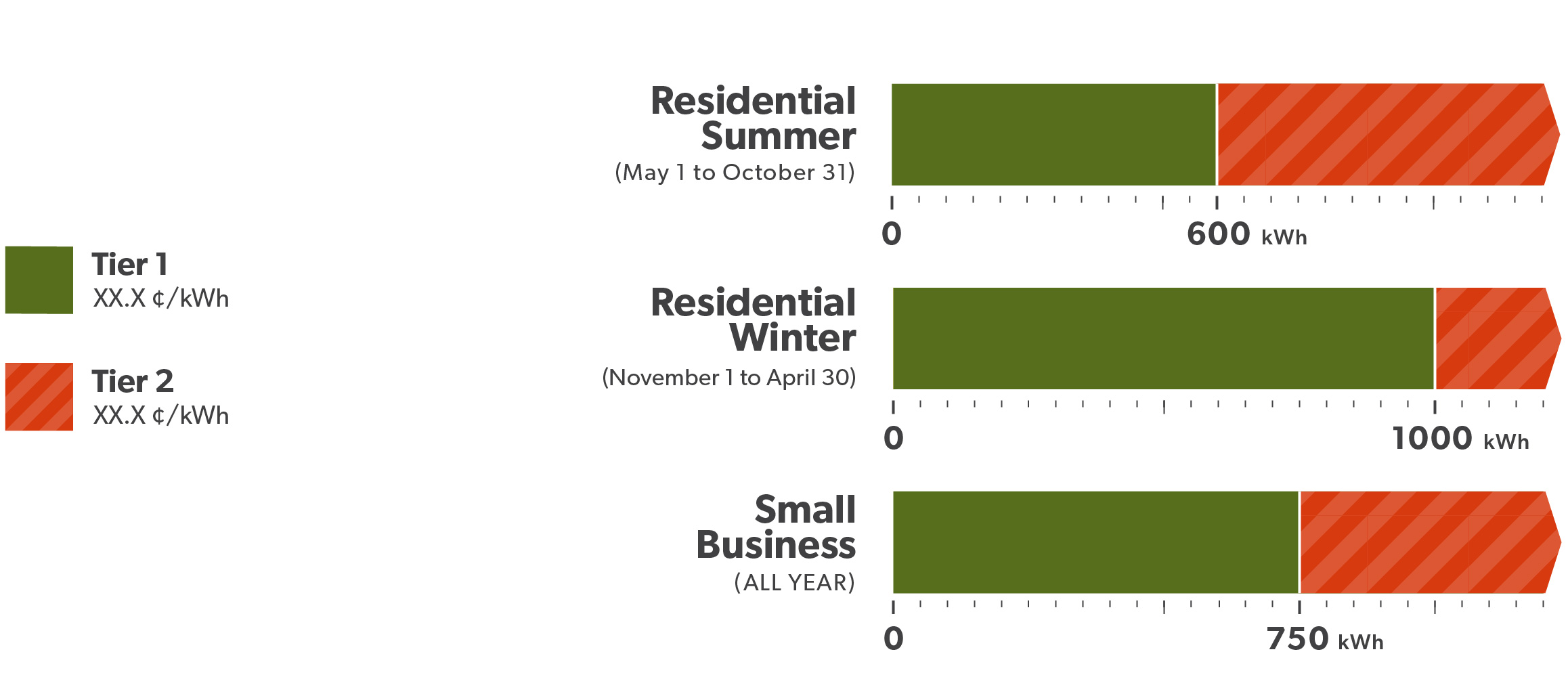You can choose your price plan
If you’re a residential or small business customer, you can choose to switch between Time-of-Use (TOU), Ultra-Low Overnight (ULO) and Tiered prices.
To switch price plans, you must notify your utility by completing an election form. You must contact your utility or visit their website for the election form. If you want to stay with your current price plan no action is required.
Considering a switch? Your top questions answered here. Or learn more below.
About the price plans
Learn the difference between TOU, ULO and Tiered price plans.
With TOU and ULO, the price depends on when you use electricity. This means you can help manage your electricity costs by shifting your usage to lower price periods when possible.
With Tiered, the price depends on how much electricity you use overall in a month.
About TOU
There are three TOU price periods:
- Off-peak, when demand for electricity is generally lower. Ontario households use most of their electricity – nearly two thirds of it – during off-peak hours.
- Mid-peak, when demand for electricity is moderate. These periods are during the daytime, but not the busiest times of day.
- On-peak, when demand for electricity is generally higher. These are the busier times of day – generally when people are cooking, starting up their personal electronics and running heaters or air conditioners.
TOU price periods are different in the summer (May 1 – October 31) than they are in the winter (November 1 – April 30).

About ULO
There are four ULO price periods:
- Ultra-Low Overnight, when demand for electricity is lowest on average.
- Weekend Off-peak, when demand for electricity is generally lower.
- Mid-peak, when demand for electricity is moderate.
- On-peak, when demand for electricity is highest on average.
The ULO price periods are the same in the summer as they are in the winter.

About Tiered
With Tiered prices, you can use a certain amount of electricity each month at a lower price. Once that limit (called a threshold) is exceeded, a higher price applies. The threshold changes with the season to reflect changing usage patterns – for example, there are fewer hours of daylight in the winter and some customers use electric heating.
In the winter period (November 1 – April 30), the Tier threshold for residential customers is 1,000 kWh, so that during the heating season households can use more power at the lower price. In the summer period (May 1 – October 31), the Tier threshold for residential customers is 600 kWh. The Tier threshold for small business customers is 750 kWh all year round.
Tiered prices give you the flexibility to use electricity at any time of day at the same price, although that price will change if you exceed the threshold during the month.

About TOU, ULO and Tiered Pricing under the Regulated Price Plan
We set TOU, ULO and Tiered prices under the Regulated Price Plan (RPP). The RPP is designed to provide stable pricing, encourage conservation and ensure that the price customers pay for electricity better reflects the price paid to generators that produce the electricity consumers use in their homes or small businesses. We set TOU, ULO and Tiered prices so that they all recover the same forecast average cost of supply for a typical consumer.
Power is personal. Some customers may prefer TOU or ULO prices. For instance, customers who work different shifts may be able to use more of their electricity at times when lower off-peak prices apply, and some customers, like those who charge their electric vehicles, may also want to take advantage of the Ultra-Low Overnight price that applies from 11 p.m. until 7 a.m. every day. Others may favour Tiered prices because they want the flexibility to do their household chores at any time of the day, or their total usage rarely exceeds 600 kWh in a month in summer, or 1,000 kWh in a month in winter.
Whatever plan you choose, one thing remains certain: the less electricity you use, the less you pay. Switching price plans will not affect your eligibility for the Ontario Electricity Rebate or other government programs like the Ontario Electricity Support Program that supports low-income households in need of assistance in paying their electricity bills.
Are you thinking about changing your price plan? Here are a few things to consider. Make sure you have some of your recent electricity bills handy as you go through the information below.
Your price plan
What electricity price plan are you on? If you’re unsure, take a look at the Electricity line of your bill. Most residential and small business customers in Ontario pay TOU prices.
Your usage
How much electricity do you use in a month? If you’re unsure, take a look at the Electricity line on your bill. You might also want to look at the historical usage graph on your bill, which shows your average daily use over the past 12-month period.
Your consumption pattern
When you use electricity can be another factor in your choice. Historically, the typical residential customer who paid TOU prices has used nearly two thirds of their power during off-peak times – the time when the lowest TOU price applies. The other third of their power use was typically split equally between on- and mid-peak times. Look at the Electricity line of your bill to see how much power you use in each of the three TOU price periods.
Seasonal changes
TOU price periods and the Tier threshold for residential customers change with the season and are different during the winter (November 1 – April 30) and summer (May 1 – October 31). ULO price periods are the same all year round.
Does the amount of electricity you use change based on the season?
For instance, if you heat your home electrically, your monthly use in the winter may be higher. The same goes for the summer if you need to run your air conditioner.
Lifestyle and daily habits
Are you often home during the day on weekdays, so that shifting your usage is more challenging? Do you have large appliances that you need to run during the day on weekdays? Can you shift more of that usage to nighttime or weekend hours? Do you own an electric vehicle and at what times of day/night do you charge it?
We've created videos that feature the lifestyles of different customers considering their pricing options. Watch them below.
Small businesses
If you’re a small business owner, some of the same factors mentioned earlier also apply – how much electricity do you use each month, and when do you use it? Keep in mind that the Tier threshold for small business customers is 750 kWh all year round. And not all small businesses are the same. A large restaurant with several ovens running in the evening may have very a different electricity usage pattern than a small salon that’s only open during the day. So may a dry cleaner compared to a convenience store, or a clothing store compared to a bakery.
Watch our videos that feature the lifestyles of different customers considering their pricing options.
Bill calculator
There is no guarantee you will save money if you switch between TOU, ULO and Tiered prices. The total bill impact of switching will vary depending on how much electricity is used in a month and when it is used during the day.

If you don’t want to switch your price plan, you don’t need to do anything. You will stay on your current price plan.
If you do want to switch to a different price plan, here are the rules that apply.
Election form
- You’ll need to fill out an election form to notify your electricity utility that you want to switch.
- Electricity utilities must make election forms available on their websites and to any customer that requests it. At a minimum, they must accept election forms by email or mail. You may be able to fill out a form online or over the phone. Contact your electricity utility to find out if these options are available.
- You should have a recent electricity bill on hand when filling out the form, as you will need your utility account number. For help to find the account number and other parts of an electricity bill, see our sample bills:
- Within 10 business days of receiving your election form, your electricity utility must:
- Tell you if your election form can’t be processed and must explain why (for instance, if you’re not authorized to make changes to the account, or the account can’t be verified)
or
- If there are no issues with your election form, let you know when you can expect to start being billed on the new price plan.
- Tell you if your election form can’t be processed and must explain why (for instance, if you’re not authorized to make changes to the account, or the account can’t be verified)
The switch
- A switch between price plans can only take effect at the start of a billing period. A billing period is generally around 30 days, but that can vary. The start and end dates are identified on your electricity bill. The start of your billing period can be any given day of a month. Many customers are not billed based on a calendar month.
- If your electricity utility receives your completed election form at least 10 business days before the start of your next billing period, it must start charging you under your requested price plan as of your next billing period.
- If your electricity utility receives your completed election form less than 10 business days before the start of your next billing period, it might still be able to switch you for your next billing period. But if it can’t do so, it has to start charging you under your requested price plan at the start of the next billing period after that.
- Between the time that you submit your election form and the time that your choice takes effect, you will continue to pay pricing under your old price plan.
- You can switch between price plans at any time. For example, if you switch from TOU to ULO, you are not locked in. You can switch back. The process described above applies.
Other things you should know
- Electricity utilities are required to inform all new residential and small business customers that they have a choice between TOU, ULO or Tiered prices when they set up the account.
- The choice between TOU, ULO and Tiered prices is available to residential and small business customers that have smart meters and are billed under the OEB’s RPP. Some residential and small business customers are charged Tiered prices because their meters can’t be used to bill TOU prices. They can’t switch to TOU or ULO prices at this time.
- If you live in a condominium or apartment that has its own individual meter and your bill comes from a company other than an electricity utility, you are a customer of a unit sub-meter provider (USMP). Customers of USMPs also can’t switch price plans. That decision can only be made for the building as a whole by the “principal consumer,” who is the person that retained a USMP for the property. In most cases, the principal consumer is the property manager, landlord or condominium board.
- Customers buying their electricity from an energy retailer pay the electricity price set out in their contract. Once they have left their retail contract, they will have a choice between paying TOU, ULO or Tiered prices. For details about your energy contract, contact your energy retailer.
Still have questions?
Contact us or your electricity utility.
If you want to switch price plans, you must contact your electricity utility for the election form. The OEB does not process requests to switch.

